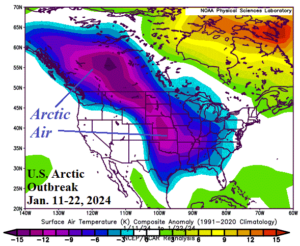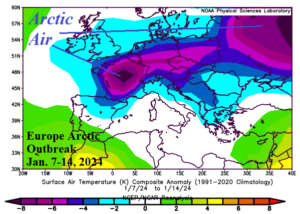Most Negative Daily Southern Oscillation Index of El Nino 2023-24 Spawns California “Bomb Cyclone”
02/06/2024, 2:29 pm ESTOceanic El Nino Is Weakening Slowly; Atmospheric El Nino Has Just Peaked
02/19/2024, 9:17 am ESTDiscussion: So far, during winter 2023-24 in North America, the prevailing climate is exceptionally mild across Canada and the Northern U.S. (Fig. 1). However, an 11-day period of hostile cold interrupted the warmth on Jan. 11-21 thanks to cross polar arctic airflow from Siberia (Fig. 2). Similarly, Europe has observed a very mild winter season (Fig. 3). There have been brief cold weather exceptions, one in early December and a second Jan. 7-14 featuring arctic air (Fig. 4). The sensible weather causes of the climate regime and weather events described is Pacific El Nino maritime warming influence and cold bursts caused by stratospheric warming events in the polar region. If you look at DEC/JAN/FEB northern hemisphere temperature anomalies for moderate to strong El Nino events back several decades a trend toward warmer northern latitude temperature anomalies is evident with the more recent warm ENSO events. This is due to constricting polar ice and a warmer ocean surface. Stratospheric warming events are caused in different ways. However, Rossby Waves born in the tropics with sufficient strength to bend upward and poleward in the upper atmosphere are increasingly likely when the entire tropical ocean is warmer than normal which is the case for this past winter (citing +IOD, +TNA, and +TSA climate indices). Simply stated, climate change is a long duration regime (during global warming, usually drier and warmer than normal) with brief (weather) interruptions of the opposite extreme. There are constant examples of this climate and weather combination which are increasing in recent years. Motivating the observations described were market reports issued earlier today of the unexpected 0.5% decline in U.S. manufacturing as the FED cited cold weather while U.S. utilities surged 6% due to the higher energy demand following a mild December.


Fig. 1-2: North America winter 2023-24 has been very warm with a brief very cold interruption.


Fig. 3-4: Europe winter 2023-24 has been very warm with brief very cold interruptions.
